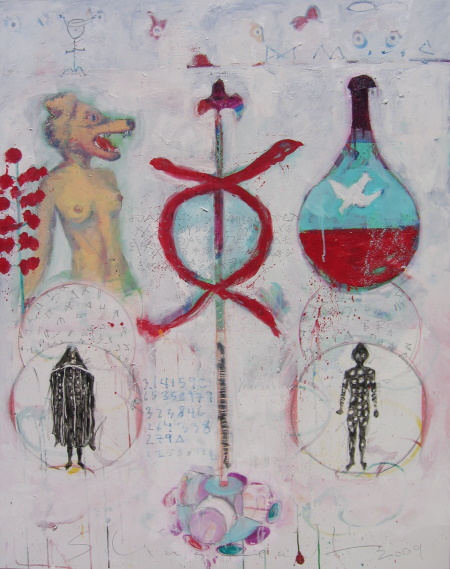
Collective Unconscious (Cynocephalus)
I attended a fascinating lecture presented by Robert Moradi, MD, sponsored by the C.G. Jung Club of Orange County. Dr. Moradi spoke about the process of active imagination as it relates to dialoging with our conscious mind to engage the unconscious. In so doing, we hold the images we receive from dreams or other sources responsible to reveal their deeper intended meaning or lesson. He suggested that this dialogue could also take place through the process of painting.
My recent observations of street art have inspired many of my recent paintings. The lecture made me realize that there is on one hand a dialogue occurring between the unconscious and the street artists and, on the other hand, a transference between the resulting images and the observer; in this case myself. The process of deciding which images to use in my paintings activates my unconscious and/or becomes a vehicle for a more global collective unconscious projection.
The selection of the image of the dog-headed woman raises some very interesting questions. The image is associated with street art found in lower Manhattan by the tag 'Peru Ana Ana Peru'. Perhaps it was the reference to Peru that first caught my eye as I have been using street images from my recent trip to Peru. Cynocephali are dog-headed people described by both pagans and early Christians. St. Christopher is the most well known example. He was portrayed as a giant cynocephalus from the 'canines' of Canaan, who barked and ate human flesh. He met the Christ child and received baptism, cleaned up his act and was rewarded with a human appearance. The idea most likely originated with the practice during those times of describing anyone living in a foreign land as being a dog-person; not too far off from some of the derogatory labels we use today for people living 'elsewhere.' In Alchemy the dog-headed human creature represents mercurius in the process of transformation, i.e. from the bestial qualities of man to the sublime.
The Egyptian version was known as Anubis the god associated with determining the worthiness of the deceased to enter the realm of light. The Greek god Hermes also had similar responsibilities and was later combined with Anubis, which lead to the god Hermanubis.
The street artist Banksy took liberties with Paris Hilton's CD released in 2006 and put a dog's head on Paris' body with comments added to the effect: "race to the bottom of the pile". In this depiction, the purity of soul (feminine) is deemed to deserve the head of a dog as a punishment for less than lofty behavior. I suspect Banksy may really be a woman.
The tag to the right of the cynocephalus is a typical territorial marker. For me it represents a basic human urge to be recognized. It is this same urge found in the caves of Lascaux, which, incidentally, Banksy had a lot of fun with his stencil of a city worker sand-blasting the 'graffiti' off the cave walls. Tagging is a way of letting the world know we exist, although it is ironically anonymous outside the inner circle, where it really counts.
The cartoon creatures were found in Central Square in Cambridge. I recognized them as the children drawings from Lima that I used in earlier paintings. Children's self-portraits juxtaposed to the more violent images offered a sense of hope for the future. In the same way these cartoon figures seemed whimsical enough to counter balance the heaviness of the images below them. The richness of street painting is often found in the multi-layered effect derived from one image being painted over another with time and weather adding their opinions. From this standpoint I painted the cartoon figures differently than the treatment of the cynocephalus and the tag as to suggest the contribution of another hand and attitude. I later saw in the characters the depiction of the five human perversions: lust (boy and girl together), anger, greed, attachment, and pride. The tag to the right of the cynocephalus is a typical territorial marker. For me it represents a basic human urge to be recognized. It is this same urge found in the caves of Lascaux, which, incidentally, Banksy had a lot of fun with his stencil of a city worker sand-blasting the 'graffiti' off the cave walls. Tagging is a way of letting the world know we exist, although it is ironically anonymous outside the inner circle, where it really counts.The bottom half of the painting contains the images of the Selknam, who represent Nature and a return to our spiritual existence. It reminds me of Jack Johnson's lyrics: "We went beyond where we should have gone". The Selknam actually act as a thread connecting us back to the caves of Lascaux, reflecting a lost cultural innocents. The overall painting depicts the layers in the unconscious starting with "the central fire" represented by the quantum string circles that make up the background of the painting. The next layer above is the "primeval ancestors" characterized by the Selknam Indians. Above this is a combination of the "nation, clan, family, and individual" layers seen in the tension of opposites of the cynocephalus, the egocentric tag, and culminating in the five perversions that provide the friction of duality necessary for the awakening of super-consciousness.
